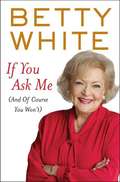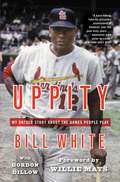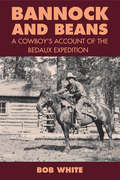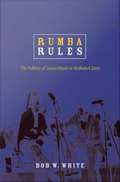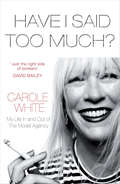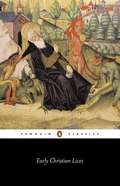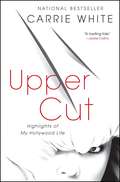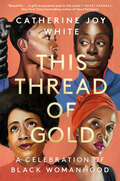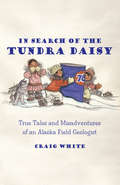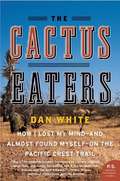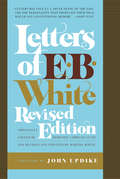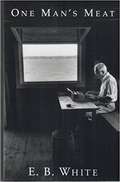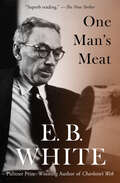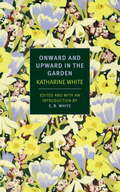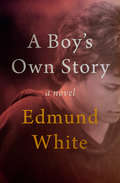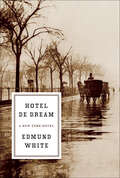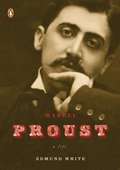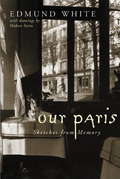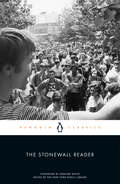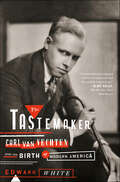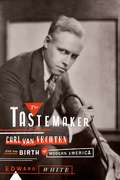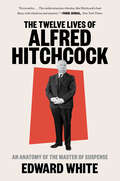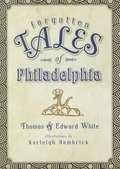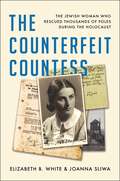- Table View
- List View
If You Ask Me (and Of Course You Won’t)
by Betty WhiteBetty White delivers a hilarious, slyly profound take on love, life, celebrity, and everything in between.
Uppity: My Untold Story About The Games People Play
by Bill White Willie MaysThere are very few major personalities in the world of sports who have so much to say about our National Pastime. And even fewer who are as well respected as Bill White.Bill White, who's now in his mid 70s, was an All-Star first baseman for many years with the New York Giants, St.Louis Cardinals and Philadelphia Phillies before launching a stellar broadcasting career with the New York Yankees for 18 years. He left the broadcast booth to become the President of the National League for five years. A true pioneer as an African-American athlete, sportscaster, and top baseball executive, White has written his long-awaited autobiography in which he will be candid, open, and as always, most forthcoming about his life in baseball. Along the way, White shares never-before-told stories about his long working relationship with Phil Rizzutto, insights on George Steinbrenner, Barry Bonds, Reggie Jackson, Thurman Munson, Bob Gibson, Bart Giamatti, Fay Vincent, and scores of other top baseball names and Hall of Famers. Best of all, White built his career on being outspoken, and the years fortunately have not mellowed him. UPPITY is a baseball memoir that baseball fans everywhere will be buzzing about.
Bannock and Beans: A Cowboy's Account of the Bedaux Expedition
by Bob White Jay SherwoodIn 1934, in the middle of the Great Depression, millionaire Charles Bedaux spent $250,000 in an attempt to cross northern British Columbia in five motorized vehicles. The Bedaux Expedition ranks as one of the most audacious and unusual events in the province's history. Bannock and Beans tells the story of this extravagant failure from the perspective of one of the cowboys who worked on Bedaux's team. Bob White's reminiscences, recounted in the tradition of the cowboy storyteller, describe the hardships of cutting trails and hauling supplies on horseback, the beauty of the wilderness landscape and many of the unique aspects of the expedition. Bannock and Beans also reveals the complex character of the expedition's leader, Charles Bedaux, a French entrepreneur who made his fortune in the United States. The book includes White's experiences in Bedaux's attempts to develop a ranch in northern BC after the expedition. Editor Jay Sherwood supplements with original Bedaux Expedition correspondence and photographs to show Bedaux's strong attachment to the remote wilderness area of northern BC from 1926 to 1939. Bannock and Beans provides new information and a fresh perspective on this unique event in BC's history. White's memoirs take us back to the campfire stories of people who were part of the vast wilderness that still covered much of the northern part of the province 75 years ago.
Rumba Rules: The Politics of Dance Music in Mobutu's Zaire
by Bob W. WhiteMobutu Sese Seko, who ruled Zaire (now the Democratic Republic of Congo) from 1965 until 1997, was fond of saying "happy are those who sing and dance," and his regime energetically promoted the notion of culture as a national resource. During this period Zairian popular dance music (often referred to as la rumba zaroise) became a sort of musica franca in many parts of sub-Saharan Africa. But how did this privileged form of cultural expression, one primarily known for a sound of sweetness and joy, flourish under one of the continent's most brutal authoritarian regimes? In Rumba Rules, the first ethnography of popular music in the Democratic Republic of Congo, Bob W. White examines not only the economic and political conditions that brought this powerful music industry to its knees, but also the ways that popular musicians sought to remain socially relevant in a time of increasing insecurity. Drawing partly on his experiences as a member of a local dance band in the country's capital city Kinshasa, White offers extraordinarily vivid accounts of the live music scene, including the relatively recent phenomenon of libanga, which involves shouting the names of wealthy or powerful people during performances in exchange for financial support or protection. With dynamic descriptions of how bands practiced, performed, and splintered, White highlights how the ways that power was sought and understood in Kinshasa's popular music scene mirrored the charismatic authoritarianism of Mobutu's rule. In Rumba Rules, Congolese speak candidly about political leadership, social mobility, and what it meant to be a bon chef (good leader) in Mobutu's Zaire.
Have I Said Too Much?: My Life In and Out of The Model Agency
by Carole WhiteThere are model agents and there is Carole White …Every decade in Carole White’s life has been extraordinary, from her childhood in Colonial Ghana, her rebellious teenage years and own modelling career, to spending 30 years at the helm of her iconic London agency Premier.Christy, Naomi, Linda, Claudia, Cindy … White has shaped the careers of the most superlative names ever to grace a catwalk and was at the centre of the 90s supermodel storm in all its glory, drama and excess.There have been landmark court cases, size zero debates, tantrums and triumphs. And who could forget her starring role as the much-loved ‘witch’ in award-winning reality show The Model Agency?Carole’s got opinions and she’s not afraid to share them. Have I Said Too Much? is the frank and revealing story of the grande dame of modelling, as well as an exclusive insight in to this thrilling, glamorous and chaotic industry.
Early Christian Lives
by Carolinne White Gregory The Great Jerome Sulpicius Severus Hilarion Staff Gregory Athanasius Saint Jerome<P>Written between the mid-fourth and late sixth centuries to commemorate and glorify the achievements of early Christian saints, these six biographies depict men who devoted themselves to solitude, poverty and prayer. <P>Athanasius records Antony’s extreme seclusion in the Egyptian desert, despite temptation by the devil and visits from his followers. <P>Jerome also shows those who fled persecution or withdrew from society to pursue lives of chastity and asceticism in his accounts of Paul of Thebes, Hilarion, and Malchus.<P> In his Life of Martin, Sulpicius Severus describes the achievements of a man who combined the roles of monk, bishop and missionary, while Gregory the Great tells of Benedict, whose Rule became the template for monastic life.<P> Full of vivid incidents and astonishing miracles, these Lives have provided inspiration as models for centuries of Christian worship.
Upper Cut: Highlights of My Hollywood Life
by Carrie WhiteI was living a hairdresser's dream. I was making my mark in this all-male field. My appointment book was filled with more and more celebrities. And I was becoming competition for my heroes . . . Behind the scenes of every Hollywood photo shoot, TV appearance, and party in the '60s, '70s, and '80s, there was Carrie White. As the "First Lady of Hairdressing," Carrie collaborated with Richard Avedon on shoots for Vogue, partied with Jim Morrison, gave Sharon Tate her California signature style, and got high with Jimi Hendrix. She has counted Jennifer Jones, Betsy Bloomingdale, Elizabeth Taylor, Goldie Hawn, and Camille Cosby among her favorite clients. But behind the glamorous facade, Carrie's world was in perpetual disarray and always had been. After her father abandoned the family when she was still a child, she was sexually abused by her domineering stepfather, and her alcoholic mother was unstable and unreliable. Carrie was sipping cocktails before her tenth birthday, and had had five children and three husbands before her twenty-eighth. She fueled the frenetic pace of her professional life with a steady diet of champagne and vodka, diet pills, cocaine, and heroin, until she eventually lost her home, her car, her career--and nearly her children. But she battled her way back, getting sober, rebuilding her relationships and her reputation as a hairdresser, and today, the name Carrie White is once again on the door of one of Beverly Hills's most respected salons. An unflinching portrayal of addiction and recovery, Upper Cut proves that even in Hollywood, sometimes you have to fight for a happy ending. * Includes sixty rare photographs*
Upper Cut
by Carrie WhiteI was living a hairdresser's dream. I was making my mark in this all-male field. My appointment book was filled with more and more celebrities. And I was becoming competition for my heroes . . . Behind the scenes of every Hollywood photo shoot, TV appearance, and party in the '60s, '70s, and '80s, there was Carrie White. As the "First Lady of Hairdressing," Carrie collaborated with Richard Avedon on shoots for Vogue, partied with Jim Morrison, gave Sharon Tate her California signature style, and got high with Jimi Hendrix. She has counted Jennifer Jones, Betsy Bloomingdale, Elizabeth Taylor, Goldie Hawn, and Camille Cosby among her favorite clients. But behind the glamorous facade, Carrie's world was in perpetual disarray and always had been. After her father abandoned the family when she was still a child, she was sexually abused by her domineering stepfather, and her alcoholic mother was unstable and unreliable. Carrie was sipping cocktails before her tenth birthday, and had had five children and three husbands before her twenty-eighth. She fueled the frenetic pace of her professional life with a steady diet of champagne and vodka, diet pills, cocaine, and heroin, until she eventually lost her home, her car, her career--and nearly her children. But she battled her way back, getting sober, rebuilding her relationships and her reputation as a hairdresser, and today, the name Carrie White is once again on the door of one of Beverly Hills's most respected salons. An unflinching portrayal of addiction and recovery, Upper Cut proves that even in Hollywood, sometimes you have to fight for a happy ending.
This Thread of Gold: A Celebration of Black Womanhood
by Catherine Joy White&“Beautiful… A gift to ourselves and to the world.&”— Mikki Kendall, New York Times bestselling author of Hood FeminismFrom gender adviser to the UN Catherine Joy White comes This Thread of Gold, a lyrical celebration of the history of Black women who challenged stereotypes through film, politics, activism, and beyond. This immersive and empowering read blends history, reporting, and personal stories to weave a gorgeous tapestry from the resilience of Black women. As White writes, &“Black women are not victims. Black women are alchemists, spinning gold from a life of hardship. . . . This book is dedicated solely to Black women surviving, thriving, and glowing.&” White&’s book features revolutionary women from across time and space, liberating them from reductive stereotypes like &“the strong Black woman,&” and allowing space for emotional nuance, individual motivation, and richness of expression. White offers fresh insights into the work of Beyoncé and Nina Simone, Shirley Chisholm and Meghan Markle, as well as the work of those who resisted in secret—in kitchens, in churches, and through trusted networks. By weaving these women together, White reveals new ways to understand Black womanhood and she is sure to inspire new generations of readers.
In Search of the Tundra Daisy: True Tales and Misadventures of an Alaska Field Geologist
by Craig WhiteDisillusioned with life in the city, and spurred on by childhood dreams of adventure and discovery, a young geologist take a chance and moves his family to Alaska during the 1970s' pipeline boom. Awed and humbled by the Great Land and its unpredictable inhabitants--animal and human--he begins a 20-year search for the elusive tundra daisy--a giant oilfield with the potential to put him and his discovery o the map. Unexpectedly, however, this young explorer's search yields more than black gold when he discovers that life's greatest lessons are often learned under difficult circumstances. A mix of harrowing, humorous, and heartwarming true stories, Craig White's Tundra Daisy embodies the spirit of a real Alaskan, and recaptures a bygone era of discovery in the Last Frontier.
The Cactus Eaters: How I Lost My Mind -- and Almost Found Myself -- on the Pacific Crest Trail
by Dan WhiteThe Pacific Crest Trail stretches from Mexico to Canada, a distance of 2,650 grueling, sun-scorched, bear-infested miles. When Dan White and his girlfriend announced their intention to hike it, Dan's parents--among others--thought they were nuts. How could two people who'd never even shared an apartment together survive six months in the desert with little more than a two-person tent and some trail mix? But when these addled adventurers, dubbed "the Lois and Clark Expedition" by their benevolent trail-guru, set out for the American wilderness, the hardships of the trail--and one delicious-looking cactus--test the limits of love and sanity.
Letters of E.B. White
by E. B. WhiteOriginally edited by Dorothy Lobrano Guth, and revised and updated by Martha White Foreword by John Updike These letters are, of course, beautifully written but above all personal, precise, and honest. They evoke E. B. White's life in New York and in Maine at every stage of his life. They are full of memorable characters: White's family, the New Yorker staff and contributors, literary types and show business people, farmers from Maine and sophisticates from New York–Katherine S. White, Harold Ross, James Thurber, Alexander Woolcott, Groucho Marx, John Updike, and many, many more. Each decade has its own look and taste and feel. Places, too–from Belgrade (Maine) to Turtle Bay (NYC) to the S. S. Buford, Alaska–bound in 1923–are brought to life in White's descriptions. There is no other book of letters to compare with this; it is a book to treasure and savor at one's leisure. As White wrote in this book, "A man who publishes his letters becomes nudist–nothing shields him from the world's gaze except his bare skin. . . . a man who has written a letter is stuck with it for all time. "
One Man's Meat
by E. B. WhiteCollection of essays on the author's personal life written for The New Yorker Harper's Magazine.
One Man's Meat
by E. B. WhiteThe Pulitzer Prize–winning writer and author of Charlotte&’s Web documents his move from Manhattan to a saltwater farm in New England: &“Superb reading.&” —The New Yorker Called &“a mid-20th–century Thoreau&” by Notre Dame Magazine, E. B. White&’s desire to live a simple life caused him to sell half his worldly goods, give up his job writing the New Yorker&’s &“Notes and Comment&” editorial page, and move with his family to a saltwater farm in North Brooklin, Maine. There, White got into the nuts-and-bolts of rural life—not without a lot of self-reflection—and surrounded himself with barnyard characters, some of whom would later appear in Charlotte&’s Web.One Man&’s Meat is White&’s collection of pithy and unpretentious essays on such topics as living with hay fever (&“I understand so well the incomparable itch of eye and nose for which the only relief is to write to the President of the United States&”), World War II (&“I stayed on the barn, steadily laying shingles, all during the days when Mr. Chamberlain, M. Daladier, the Duce, and the Führer were arranging their horse trade&”), and even dog training (&“Being the owner of dachshunds, to me a book on dog discipline becomes a volume of inspired humor&”). Though first published in 1942, this book delivers timeless lessons on the value of living close to nature in our quest for self-discovery. With each subject broached and reflected upon, it &“becomes an ardent and sobering guidebook for those of us trying to live our day-to-day lives now&” (Pif magazine). &“The most succinct, graceful and witty of essayists.&” —San Francisco Examiner and Chronicle &“A lively record of an active inquiring mind.&” —Kirkus Reviews
Onward and Upward in the Garden
by E. B. White Katherine S. WhiteIn 1925 Harold Ross hired Katharine Sergeant Angell as a manuscript reader for The New Yorker. Within months she became the magazine's first fiction editor, discovering and championing the work of Vladimir Nabokov, John Updike, James Thurber, Marianne Moore, and her husband-to-be, E. B. White, among others. After years of cultivating fiction, White set her sights on a new genre: garden writing. On March 1, 1958, The New Yorker ran a column entitled "Onward and Upward in the Garden," a critical review of garden catalogs, in which White extolled the writings of "seedmen and nurserymen," those unsung authors who produced her "favorite reading matter." Thirteen more columns followed, exploring the history and literature of gardens, flower arranging, herbalists, and developments in gardening. Two years after her death in 1977, E. B. White collected and published the series, with a fond introduction. The result is this sharp-eyed appreciation of the green world of growing things, of the aesthetic pleasures of gardens and garden writing, and of the dreams that gardens inspire.
A Boy's Own Story: A Novel (Modern Library #47)
by Edmund White&“An extraordinary novel&” about growing up gay in the 1950s American Midwest (The New York Times Book Review). Critically lauded upon its initial publication in 1982 for its pioneering depiction of homosexuality, A Boy&’s Own Story is a moving tale about coming-of-age in midcentury America. With searing clarity and unabashed wit, Edmund White&’s unnamed protagonist yearns for what he knows to be shameful. He navigates an uneasy relationship with his father, confounds first loves, and faces disdain from his peers at school. In the embrace of another, he discovers the sincere and clumsy pleasures of adolescent sexuality. But for boys in the 1950s, these desires were unthinkable. Looking back on his experiences, the narrator notes, &“I see now that what I wanted was to be loved by men and to love them back but not to be a homosexual.&” From a winner of the PEN/Saul Bellow Award for Lifetime Achievement in Literature, this trailblazing autobiographical story of one boy&’s youth is a moving, tender, and heartbreaking portrait of what it means to grow up.
Hotel de Dream: A New York Novel
by Edmund WhiteIn a damp, old Sussex castle, American literary phenomenon Stephen Crane lies on his deathbed, wasting away from tuberculosis at the age of twenty-eight. The world-famous author has retreated to England with his wife, Cora, in part to avoid gossip about her ignominious past as the proprietress of an infamous Florida bordello, the Hotel de Dream. In the midst of gathering tragedy, Crane begins dictating what will surely be his final work: a strange and poignant novel of a boy prostitute in 1890s New York and the married man who ruins his own life to win his love.
Marcel Proust: A Life
by Edmund WhiteIf there is anyone worthy of producing an intimate biography of the enigmatic genius behind Remembrance of Things Past, it is Edmund White, himself an award- winning writer for whom Marcel Proust has long been an obsession. <P><P>White introduces us not only to the recluse endlessly rewriting his one massive work through the night, but also the darling of Parisian salons, the grasper after honors, and the closeted homosexual-a subject this book is the first to explore openly. <P>From the frothiest gossip to the deepest angst, here is a moving portrait to be treasured by anyone looking for an introduction to this literary icon.
Our Paris: Sketches from Memory
by Edmund WhiteWhat happens when one of our most celebrated writers combines talents with a French artist and architect to capture life in their Parisian neighborhood? The result is a lighthearted, gently satiric portrait of the heart of Paris -- including the Marais, Les Halles, the two islands in the Seine, and the Châtelet -- and the people who call it home. It is an enchantingly varied world, populated not only by dazzling literati and ultrachic couturiers and art dealers but also by poetic shopkeepers, grandmotherly prostitutes, and, ever underfoot, an irrepressible basset hound named Fred. The foibles and eccentricities of these sometimes outrageous, always memorable individuals are brought to life with unfailing wit and affection. Below the surface of the sparkling humor in Our Paris, there is a tragic undercurrent. While Hubert Sorin was completing this work, he was nearing the end of his struggle with AIDS. The book is a tribute to the loving spirit with which the authors banished somberness and celebrated the pleasures of their life together.
The Stonewall Reader
by Edmund White New York Public LibraryFor the fiftieth anniversary of the Stonewall uprising, an anthology chronicling the tumultuous fight for LGBTQ rights in the 1960s and the activists who spearheaded it, with a foreword by Edmund White. <P><P>June 28, 2019 marks the fiftieth anniversary of the Stonewall uprising, which is considered the most significant event in the gay liberation movement, and the catalyst for the modern fight for LGBTQ rights in the United States. <P><P>Drawing from the New York Public Library's archives, The Stonewall Reader is a collection of first accounts, diaries, periodic literature, and articles from LGBTQ magazines and newspapers that documented both the years leading up to and the years following the riots. <P><P> Most importantly the anthology spotlights both iconic activists who were pivotal in the movement, such as Sylvia Rivera, co-founder of Street Transvestites Action Revolutionaries (STAR), as well as forgotten figures like Ernestine Eckstein, one of the few out, African American, lesbian activists in the 1960s. <P><P>The anthology focuses on the events of 1969, the five years before, and the five years after. Jason Baumann, the NYPL coordinator of humanities and LGBTQ collections, has edited and introduced the volume to coincide with the NYPL exhibition he has curated on the Stonewall uprising and gay liberation movement of 1969.
The Tastemaker: Carl Van Vechten and the Birth of Modern America
by Edward WhiteA revealing biography of the influential and controversial cultural titan who embodied an eraThe Tastemaker explores the many lives of Carl Van Vechten, the most influential cultural impresario of the early twentieth century: a patron and dealmaker of the Harlem Renaissance, a photographer who captured the era's icons, and a novelist who created some of the Jazz Age's most salacious stories. A close confidant of Langston Hughes, Gertrude Stein, George Gershwin, F. Scott Fitzgerald, and the Knopfs, Van Vechten frolicked in the 1920s Manhattan demimonde, finding himself in Harlem's jazz clubs, Hell's Kitchen's speakeasies, and Greenwich Village's underground gay scene. New York City was a hotbed of vice as well as creativity, and Van Vechten was at the center of it all.Edward White's biography—the first comprehensive biography of Carl Van Vechten in nearly half a century, and the first to fully explore Van Vechten's tangled relationship to race and sexuality—depicts a controversial figure who defined an age. Embodying many of the contradictions of modern America, Van Vechten was a devoted husband with a coterie of boys by his side, a supporter of difficult art who also loved lowbrow entertainment, and a promoter of the Harlem Renaissance whose bestselling novel—and especially its title—infuriated many of the same African-American artists he championed. Van Vechten's defense of what many Americans considered bad taste—modernist literature, African-American culture, and sexual self-expression—created a popular appetite for these quintessential elements of American art. The Tastemaker encompasses its subject's private fears and longings, as well as Manhattan's raucous, taboo-busting social scene of which he was such a central part. It is a remarkable portrait of a man whose brave journeys across boundaries of race, sexuality, and taste helped make America fully modern.
The Tastemaker: Carl Van Vechten and the Birth of Modern America
by Edward WhiteA revealing biography of the influential and controversial cultural titan who embodied an era The Tastemaker explores the many lives of Carl Van Vechten, the most influential cultural impresario of the early twentieth century: a patron and dealmaker of the Harlem Renaissance, a photographer who captured the era's icons, and a novelist who created some of the Jazz Age's most salacious stories. A close confidant of Langston Hughes, Gertrude Stein, George Gershwin, F. Scott Fitzgerald, and the Knopfs, Van Vechten frolicked in the 1920s Manhattan demimonde, finding himself in Harlem's jazz clubs, Hell's Kitchen's speakeasies, and Greenwich Village's underground gay scene. New York City was a hotbed of vice as well as creativity, and Van Vechten was at the center of it all. Edward White's biography--the first comprehensive biography of Carl Van Vechten in nearly half a century, and the first to fully explore Van Vechten's tangled relationship to race and sexuality--depicts a controversial figure who defined an age. Embodying many of the contradictions of modern America, Van Vechten was a devoted husband with a coterie of boys by his side, a supporter of difficult art who also loved lowbrow entertainment, and a promoter of the Harlem Renaissance whose bestselling novel--and especially its title--infuriated many of the same African-American artists he championed. Van Vechten's defense of what many Americans considered bad taste--modernist literature, African-American culture, and sexual self-expression--created a popular appetite for these quintessential elements of American art. The Tastemaker encompasses its subject's private fears and longings, as well as Manhattan's raucous, taboo-busting social scene of which he was such a central part. It is a remarkable portrait of a man whose brave journeys across boundaries of race, sexuality, and taste helped make America fully modern.
The Twelve Lives of Alfred Hitchcock: An Anatomy Of The Master Of Suspense
by Edward WhiteWinner of the 2022 Edgar Award for Best Biography An Economist Best Book of 2021 A fresh, innovative biography of the twentieth century’s most iconic filmmaker. In The Twelve Lives of Alfred Hitchcock, Edward White explores the Hitchcock phenomenon—what defines it, how it was invented, what it reveals about the man at its core, and how its legacy continues to shape our cultural world. The book’s twelve chapters illuminate different aspects of Hitchcock’s life and work: “The Boy Who Couldn’t Grow Up”; “The Murderer”; “The Auteur”; “The Womanizer”; “The Fat Man”; “The Dandy”; “The Family Man”; “The Voyeur”; “The Entertainer”; “The Pioneer”; “The Londoner”; “The Man of God.” Each of these angles reveals something fundamental about the man he was and the mythological creature he has become, presenting not just the life Hitchcock lived but also the various versions of himself that he projected, and those projected on his behalf. From Hitchcock’s early work in England to his most celebrated films, White astutely analyzes Hitchcock’s oeuvre and provides new interpretations. He also delves into Hitchcock’s ideas about gender; his complicated relationships with “his women”—not only Grace Kelly and Tippi Hedren but also his female audiences—as well as leading men such as Cary Grant, and writes movingly of Hitchcock’s devotion to his wife and lifelong companion, Alma, who made vital contributions to numerous classic Hitchcock films, and burnished his mythology. And White is trenchant in his assessment of the Hitchcock persona, so carefully created that Hitchcock became not only a figurehead for his own industry but nothing less than a cultural icon. Ultimately, White’s portrayal illuminates a vital truth: Hitchcock was more than a Hollywood titan; he was the definitive modern artist, and his significance reaches far beyond the confines of cinema.
Forgotten Tales of Philadelphia
by Edward White Thomas WhiteRecounts little-known, obscure, bizarre, and sometimes funny tales from the Philadelphia area
The Counterfeit Countess: The Jewish Woman Who Rescued Thousands of Poles During the Holocaust
by Elizabeth B. White Joanna SliwaThe astonishing story of Dr. Josephine Janina Mehlberg—a Jewish mathematician who saved thousands of lives in Nazi-occupied Poland by masquerading as a Polish aristocrat—drawing on Mehlberg&’s own unpublished memoir.World War II and the Holocaust have given rise to many stories of resistance and rescue, but The Counterfeit Countess is unique. It tells the remarkable, unknown story of &“Countess Janina Suchodolska,&” a Jewish woman who rescued more than 10,000 Poles imprisoned by Poland&’s Nazi occupiers. Mehlberg operated in Lublin, Poland, headquarters of Aktion Reinhard, the SS operation that murdered 1.7 million Jews in occupied Poland. Using the identity papers of a Polish aristocrat, she worked as a welfare official while also serving in the Polish resistance. With guile, cajolery, and steely persistence, the &“Countess&” persuaded SS officials to release thousands of Poles from the Majdanek concentration camp. She won permission to deliver food and medicine—even decorated Christmas trees—for thousands more of the camp&’s prisoners. At the same time, she personally smuggled supplies and messages to resistance fighters imprisoned at Majdanek, where 63,000 Jews were murdered in gas chambers and shooting pits. Incredibly, she eluded detection, and ultimately survived the war and emigrated to the US. Drawing on the manuscript of Mehlberg&’s own unpublished memoir, supplemented with prodigious research, Elizabeth White and Joanna Sliwa, professional historians and Holocaust experts, have uncovered the full story of this remarkable woman. They interweave Mehlberg&’s sometimes harrowing personal testimony with broader historical narrative. Like The Light of Days, Schindler&’s List, and Irena&’s Children, The Counterfeit Countess is an unforgettable account of inspiring courage in the face of unspeakable cruelty.
